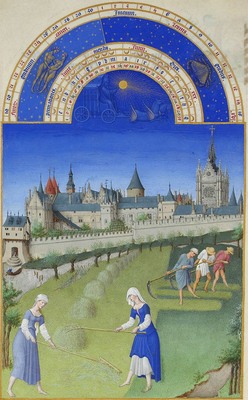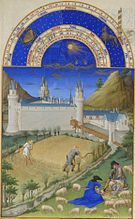A scene commonly enacted in modern times, whether in public or in private places, is that of people assiduously consulting an accessory. This often occurs in ignorance of the individual’s awareness of the social setting. Referred to here is the technical device called variously a ‘smart ’phone’ or a ‘tablet’. There was a religious parallel in the Middle Ages. This was a devotional and status-giving book called a ‘Book of Hours’, often to be seen dangling from the wrist of the wearer.
The poet Eustache Deschamps (1346-1406) wrote a satirical piece mocking this misuse of these devotional tracts. His poem, well translated into English is:
A Book of hours, too, must be mine.
Whose subtle workmanship will shine
Of gold and azure, rich and smart
Arranged and painted with great art
Covered with fine brocade of gold
And these must be so as to hold
The pages closed, two golden clasps.
The contents of Books of Hours may have had many variations, but substantially they would contain:
The Church feasts calendar
The four Gospels
Little office of the BVM
7 penitential psalms
7 psalms of degrees
Litany of saints
Office for the dead
Hours of the cross
Prayers - (and sometimes secular domestic matters of the sponsoring family).
Les Très Riches Heures du duc de Berry, which exists today and can be seen in the Musee Conde, Chantily, France, is a beautiful example of the consummate artistry to be found in Books of Hours. Lavishly illustrated with pictures and patterning, and with French Gothic text it is one of the most precious books in the world. It was created by the Limbourg brothers in about AD1416 and the duc de Berry was their patron. The Limbourgs and their successors made a specialism of producing Books of Hours for wealthy bourgeoisie and nobles all over Europe.
Books of Hours are well worth close study, not only for their ecclesiastical content, but also for their insight into the occupations and preoccupations of the mediaeval mind, as well as their artistic merit.
Rod Dawson






